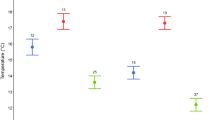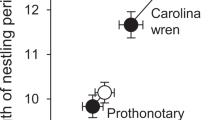Abstract
Temperature is one of the best investigated environmental factors in ecological life-history studies and is increasingly considered in the contexts of climate change and urbanization. In avian ecology, few studies have examined the associations between thermal dynamics in the nest environment and its neighbouring air. Here, we placed avian nests and non-incubated eggs inside nest boxes at various air temperatures that ranged from 0.3 to 33.1 °C, both in the field and in laboratory conditions. We measured how the design of the boxes, their compass orientation and their location in more or less urbanized environments affected the surface temperature of nests and eggs. We also assessed whether covering the eggs with lining material influenced their surface temperature. Overall, across all performed tests, we found that the surface temperature of nests and eggs strongly reflected the air temperature measured outside of the nest boxes. While the design of the nest boxes had little influence on the temperature of nests and eggs, orienting the nest boxes to the north or to the west significantly decreased their surface temperature. The presence of lining material also kept eggs slightly warmer when air temperatures were low. Altogether these results suggest that non-incubated eggs are not well protected against extreme air temperatures prior to the onset of incubation. From an evolutionary point of view, producers of ectotherm eggs need therefore to time egg-laying appropriately in order to avoid unfavourable thermal nest environments.


Similar content being viewed by others
References
Andreasson F, Nord A, Nilsson J-A (2018) Experimentally increased nest temperature affects body temperature, growth and apparent survival in blue tit nestlings. J Avian Biol e01620. https://doi.org/10.1111/jav.01620
Baker JR (1938) The evolution of breeding seasons. In: De Beer GR (ed) Evolution: essays on aspects of evolutionary biology. Oxford University Press, London, pp 161–177
Blondel J, Thomas DW, Charmantier A, Perret P, Bourgault P, Lambrechts MM (2006) A thirty-year study of phenotypic and genetic variation of blue tits in Mediterranean habitat mosaics. BioScience 56:661–673
Bornstein RD (1968) Observations of the urban heat island effect in New York City. J Appl Meteorol 7(4):575–582
Britt J, Deeming DC (2011) First-egg date and air temperature affect nest construction in blue tits Cyanistes caeruleus, but not in great tits Parus major. Bird Study 58:78–89
Cooper CB, Voss MA (2013) Avian incubation patterns reflect temporal changes in developing clutches. PLoS One 8(6):e65521. https://doi.org/10.1371/journal.pone.0065521
Cooper CB, Hochachka WM, Butcher G, Dhondt AA (2005) Seasonal and latitudinal trends in clutch size: thermal constraints during laying and incubation. Ecology 86:2018–2031
Crossman CA, Rohwer VG, Martin PR (2011) Variation in the structure of bird nests between Northern Manitoba and Southeastern Ontario. PLoS One 6(4):e19086. https://doi.org/10.1371/journal.pone.0019086
Cruz Á, Álvarez A, Barba E (2016) Nest insulation capacity during incubation and after fledgling are related. Avian Biol Res 9:22–27
Deeming DC, Mainwaring MC (2015) Functional properties of nests. In: Deeming DC, Reynolds SJ (eds) Nests, eggs, and incubation: new ideas about avian reproduction. Oxford University Press, Oxford, pp 29–49
Deeming DC, Reynold SJ (2015) Nests, eggs, and incubation: new ideas about avian reproduction. Oxford University Press, Oxford
Deeming DC, Mainwaring MC, Hartley IR, Reynolds SJ (2012) Local temperature and not latitude determines the design of blue tit and great tit nests. Avian Biol Res 5:203–208
Demeyrier V, Lambrechts MM, Perret P, Grégoire A (2016) Experimental demonstration of an ecological trap for a wild bird in a man-transformed environment. Anim Behav 118:181–190
Dhondt AA, Eykerman R, Hublé J (1983) Laying interruptions in tits Parus spp. Ibis 125:370–376
Diamond SE, Martin RA (2020) Evolutionary consequences of the urban heat island. In: Szulkin M, Munshi-South J, Charmantier A (eds) Urban evolutionary biology. Oxford University Press, Oxford. https://doi.org/10.1093/oso/9780198836841.003.0006
Gaughan JB, Lees AM, Sejian V (2017) Sixty years of animal biometeorology. Int J Biometeol. https://doi.org/10.1007/s00484-017-1459-1
Gibb J (1950) The breeding biology of the great and blue titmice. Ibis 92:507–539
Gil D, Brumm H (2014) Avian urban ecology. Oxford University Press, Oxford
Glądalski M, Bańbura M, Kaliński A, Markowski M, Skwarska J, Wawrzyniak J, Zieliński Z, Bańbura J (2018) Hatching delays in great tits and blue tits in response to an extreme cold spell: a long-term study. Int J Biometeol. https://doi.org/10.1007/s00484-018-1541-3
Goodenough AE, Maitland DP, Hart AG, Elliot SL (2008) Nestbox orientation: a species-specific influence on occupation and breeding success in woodland passerines. Bird Study 55:222–232
Hafthorn S (1981) Incubation during the egg-laying period in relation to clutch-size and other aspects of reproduction in the great tit Parus major. Ornis Scand 12:169–185
Harrison C (1982) An atlas of the birds of the Western Palaearctic. Collins, London 322 pp
Heenan CB, Goodman BA, White CR (2015) The influence of climate on avian nest construction across large geographic gradients. Glob Ecol Biogeogr 24:1203–1211
Imhoff ML, Zhang P, Wolfe RE, Bounoua L (2010) Remote sensing of the urban heat island effect across biomes in the continental USA. Remote Sens Environ 114:504–513. https://doi.org/10.1016/j.rse.2009.10.008
IPCC Report on Climate Change (2014) Synthesis Report. In: Core Writing Team, Pachauri RK, Meyer LA (eds) Contribution of working groups I, II and III to the Fifth Assessment Report of the Intergovernmental Panel on Climate Change. IPCC, Geneva 151 pp
Kluijver HN (1950) Daily routines of the great tit, Parus m. major L. Ardea 38:99–135
Lambrechts MM, Adriaensen F, Ardia DR, Artemyev A, Atiénzar F, Bańbura J, Barba E, Bouvier J-C, Camprodon J, Cooper CB, Dawson RD, Eens M, Eeva T, Faivre B, Garamszegi LZ, Goodenough AE, Gosler AG, Grégoire A, Griffith SC, Gustafsson L, Scott Johnson L, Kania W, Keišs O, Llambias PE, Mainwaring MC, Mänd R, Massa B, Mazgajski TD, Møller AP, Moreno J, Naef-Daenzer B, Nilsson J-A, Norte AC, Orell M, Otter KA, Park CR, Perrins CM, Pinowski J, Porkert J, Potti J, Remeš V, Richner H, Rytkönen S, Shiao M-T, Silverin B, Slagsvold T, Smith HG, Sorace A, Stenning MJ, Stewart I, Thompson CF, Török J, Tryjanowski P, van Noordwijk AJ, Winkler DW, Ziane N (2010) The design of artificial nestboxes for the study of secondary hole-nesting birds: a review of methodological inconsistencies and potential biases. Acta Ornithol 45:1–26
Lambrechts MM, Aimé C, Midamegbe A, Galan M-J, Perret P, Grégoire A, Doutrelant C (2012) Nest size and breeding success in first and replacement clutches: an experimental study in blue tits Cyanistes caeruleus. J Ornithol 153:173–179
Lambrechts MM, Charmantier A, Demeyrier V, Lucas A, Perret S, Abouladzé M, Bonnet M, Canonne C, Faucon V, Grosset S, le Prado G, Lidon F, Noell T, Pagano P, Perret V, Pouplard S, Spitaliéry R, Bernard C, Perret P, Blondel J, Grégoire A (2017) Nest design in a changing world: great tit Parus major nests from a Mediterranean city environment as a case study. Urban Ecosyst 20:1181–1190. https://doi.org/10.1007/s11252-017-0670-5
Mainwaring MC, Hartley IR, Bearhop S, Brulez K, du Feu CR, Murphy G, Plummer KE, Webber SL, Reynolds SJ, Deeming DC (2012) Latitudinal variation in blue tit and great tit nest characteristics indicates environmental adjustment. J Biogeogr 39:1669–1677
Mainwaring MC, Hartley IR, Lambrechts MM, Deeming DC (2014) The design and function of birds’ nests. Ecol Evol 20:3909–3928
Mainwaring MC, Barber I, Deeming DC, Pike DA, Roznik EA, Hartley IR (2017) Climate change and nesting behaviour in vertebrates: a review of the ecological threats and potential for adaptive responses. Biol Rev 92:1991–2002
Maziarz M, Broughton RK, Wesołowski T (2017) Microclimate in tree cavities and nest-boxes: implications for hole-nesting birds. For Ecol Manag 389:306–313
Meijer T, Nienaber U, Langer U, Trillmich F (1999) Temperature and timing of egg-laying of European starlings. Condor 101:124–132
Nager RG, Noordwijk van AJ (1992) Energetic limitation in the egg-laying period of great tits. Proc R Soc B 249:259–263
Nord A, Nilsson J-A (2012) Context-dependent costs of incubation in the pied flycatcher. Anim Behav 84:427–436
Pendlebury CJ, Bryant DM (2005) Night-time behaviour of egg-laying tits. Ibis 147:342–345
Perrins CM (1979) British tits. Collins, London
Schaper SV, Dawson A, Sharp PJ, Gienapp P, Caro SP, Visser ME (2011) Increasing temperature, not mean temperature, is a cue for avian timing of reproduction. Am Nat 179:E55–E69
Seress G, Liker A (2015) Habitat urbanization and its effects on birds. Acta Zool Acad Sci Hung 61(4):373–408
Surgey J, du Feu CR, Deeming DC (2012) Opportunistic use of a wool-like artificial material as lining of tit (Paridae) nests. Condor 114:385–392
Visser ME, Both C, Lambrechts MM (2004) Global climate change leads to mistimed avian reproduction. Adv Ecol Res 35:89–110
Wilkin TA, Perrins CM, Sheldon BC (2007) The use of GIS in estimating spatial variation in habitat quality: a case study of lay-date in the great tit Parus major. Ibis 149:110–118
Acknowledgements
This work was supported by the city of Montpellier, the University of Montpellier, OSU-OREME, and the Mediterranean Centre for Environment and Biodiversity (LabEx CeMEB). Nicolas Lambrechts helped with monitoring. We thank Arnaud Grégoire, Stéphanie Grosset, Thierry Noell, Pascal Pagano, Vincent Perret and Gilles Tessier for their logistic support. We thank three anonymous reviewers for their very constructive comments on earlier versions of this manuscript.
Author information
Authors and Affiliations
Corresponding author
Electronic supplementary material
ESM 1
(DOCX 57 kb)
Rights and permissions
About this article
Cite this article
Lambrechts, M.M., Caizergues, A.E., Perrier, C. et al. Surface temperatures of non-incubated eggs in great tits (Parus major) are strongly associated with ambient temperature. Int J Biometeorol 64, 1767–1775 (2020). https://doi.org/10.1007/s00484-020-01958-1
Received:
Revised:
Accepted:
Published:
Issue Date:
DOI: https://doi.org/10.1007/s00484-020-01958-1




